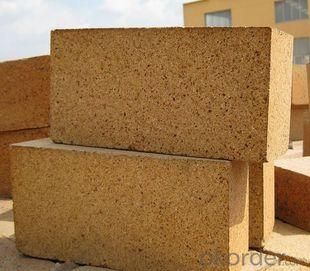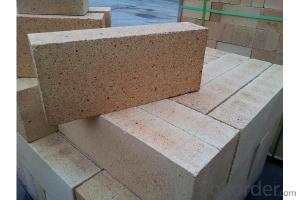High Quality Refractory Mullite Insulating Fire Brick
- Loading Port:
- Tianjin
- Payment Terms:
- TT OR LC
- Min Order Qty:
- 10 m.t.
- Supply Capability:
- 10000 m.t./month
OKorder Service Pledge
OKorder Financial Service
You Might Also Like
CNBM conforms strictly to the requirements of ISO 9000 quality control system during the production. MSDS is also available if you want. The thermal insulation fire clay brick meet with the requirements of ASTM & JIS standards. So please stay cool with our quality.
Application
Insulating Fire Brick are used for the lining of converter, alternating current arc furnace, direct Current arc furnace and the ladle slag line, etc.
Insulating Fire Brick Technical index
Brand Quality | JM23 | JM26 | JM28 | JM30 | JM32 | |
Bulk Density (g/cm3) | 0.52 | 0.78 | 0.88 | 1.03 | 1.25 | |
1.2 | 1.6 | 2.1 | 2.5 | 3.5 | ||
Modulus of Rupture (Mpa) | 0.9 | 1.4 | 1.6 | 2.1 | 2.1 | |
-0.5 | 1400℃ -0.4 | 1510℃ -0.5 | 1620℃ -0.9 | 1730℃ -0.9 | ||
Thermal Expansion 1100℃(%) |
0.5 |
0.7 |
0.8 |
0.9 |
1.1 | |
Thermal conductivity(W/m.k)
| 400℃ | 0.14 | 0.27 | 0.32 | 0.41 | 0.49 |
600℃ | 0.16 | 0.29 | 0.34 | 0.43 | 0.50 | |
800℃ | 0.18 | 0.31 | 0.36 | 0.44 | 0.51 | |
1000℃ | 0.20 | 0.33 | 0.38 | 0.45 | 0.53 | |
Al2O3 | 37 | 58 | 67 | 73 | 77 | |
Fe2O3 | 0.7 | 0.7 | 0.6 | 0.5 | 0.4 | |
Equipment
1 unit of Ceramic Abrasive (SG Abrasive) pilot production line
2 units of Compact grain Abrasive pilot production lines
1 unit of high-end coated abrasives (abrasive cloth) production line
2 units of Boron Carbide production lines
3 large flexible crushing and sieving lines for grit production lines
2 units of 2000KVA furnaces for Boron Carbide fusion
6 units of 5000KVA-10000KVA dumping type electric arc furnaces for Brown Fused Alumina fusion
Company Advantage
(1)Long Insulating Fire Brick manufacture history: 25 years manufacturer
(2)Advanced equipment
(3)Diversification of production standards: ISO ANSI FEPA JIS ASTM
(4)Flexible payment: T/T L/C D/P D/A
(5)Professional marketing team and after-sale service
(6)Free sample
FAQs
Q1 |
What’s the transport method? |
A1 | FCL delivery goods with wooden pallet or wooden case by sea; If LCL delivery, must with wooden case; Sometimes need open top, flat rack or bulk cargo. |
Q2 |
What’s the required payment term? |
A2 | Generally 30% TT as the prepayment, 70% TT before delivery. If need, 100% Irrevocable Letter of Credit or negotiation. |
Q3 |
Which country are our products exported to? |
A3 | Apart from entire Chinese market, the US, Russia, Japan, Korea, Australia and some Southeast Asian Nations. |


- Q:Can insulating fire bricks be used in ceramic kilns?
- Certainly, ceramic kilns can make use of insulating fire bricks. These bricks are specifically crafted to possess a minimal thermal conductivity, enabling them to better retain heat. Consequently, they prove to be an excellent option for lining the kiln walls, facilitating the conservation and uniform distribution of heat within the kiln chamber. Furthermore, these fire bricks are lightweight and possess exceptional resilience against thermal shock, rendering them highly durable and capable of withstanding the elevated temperatures commonly achieved in ceramic kilns.
- Q:Are insulating fire bricks resistant to sulfur dioxide?
- In general, insulating fire bricks do not possess resistance against sulfur dioxide. This highly corrosive gas can undergo reactions with the components of insulating fire bricks, resulting in their deterioration and diminished efficiency. Therefore, it is crucial to utilize refractory materials that are specifically engineered to endure exposure to sulfur dioxide, whenever such a requirement exists for the intended application.
- Q:Can insulating fire bricks be used for insulation in flues?
- Insulating fire bricks are created with the specific purpose of being used in high-temperature settings, such as furnaces, kilns, and various industrial environments. Their main function is to effectively insulate heat and prevent heat loss. However, it is important to note that they are not suitable for use in flues. Flues are exposed to extreme temperatures, corrosive gases, and the possibility of accumulation of soot and creosote. The conditions in flues are not compatible with insulating fire bricks, as they are not designed to withstand such harsh elements. Consequently, when exposed to the acidic and corrosive gases generated by combustion, these bricks may deteriorate or develop cracks over time. To ensure proper insulation in flues, it is advisable to opt for materials that are specifically manufactured for this purpose, such as refractory cement or ceramic fiber insulation. These materials are better equipped to withstand the challenging conditions encountered in flues and are more capable of providing effective insulation while maintaining the safety and durability of the flue system.
- Q:Can insulating fire bricks be used in the construction of pottery kiln shelves?
- Yes, insulating fire bricks can be used in the construction of pottery kiln shelves. Insulating fire bricks are designed to withstand high temperatures and provide excellent insulation, making them an ideal material for kiln shelves. They can help maintain consistent heat distribution and prevent thermal shock, which is important for firing pottery. Additionally, insulating fire bricks are lightweight and easy to handle, making them a practical choice for constructing kiln shelves.
- Q:Can insulating fire bricks be used in the construction of glass melting tanks?
- Indeed, the utilization of insulating fire bricks is possible for the construction of glass melting tanks. These bricks are precisely engineered to endure elevated temperatures and offer exceptional insulation characteristics. Thus, they prove to be perfect for application in glass melting tanks, where intense temperatures are necessary for the glass to melt. The insulation properties of these bricks aid in minimizing heat dissipation and preserving the desired temperature within the tank, thereby enhancing the efficiency and cost-effectiveness of the glass melting procedures. Moreover, the durability and thermal shock resistance of insulating fire bricks make them a dependable option for constructing glass melting tanks.
- Q:Can insulating fire bricks be used for insulation in flues?
- Insulating fire bricks are created with the specific purpose of being used in high-temperature settings, such as furnaces, kilns, and various industrial environments. Their main function is to effectively insulate heat and prevent heat loss. However, it is important to note that they are not suitable for use in flues. Flues are exposed to extreme temperatures, corrosive gases, and the possibility of accumulation of soot and creosote. The conditions in flues are not compatible with insulating fire bricks, as they are not designed to withstand such harsh elements. Consequently, when exposed to the acidic and corrosive gases generated by combustion, these bricks may deteriorate or develop cracks over time. To ensure proper insulation in flues, it is advisable to opt for materials that are specifically manufactured for this purpose, such as refractory cement or ceramic fiber insulation. These materials are better equipped to withstand the challenging conditions encountered in flues and are more capable of providing effective insulation while maintaining the safety and durability of the flue system.
- Q:What are the specifications of high strength diatomite insulating bricks?
- In view of the old and new concrete, steel structure, solid brick wall, hollow brick wall, compressed air brick wall and different brick wall, combined with the company installation patent method, it is suitable for the construction and installation of various types of wall. At the same time, it is also suitable for old house reconstruction. It has excellent outdoor weather resistance, color retention, alkali resistance, water resistance, scrub resistance, crack resistance, temperature resistance, waterproof, wear-resistant, collision resistant, and durable film, adhesion, and excellent anti mildew effect.
- Q:Can insulating fire bricks be used in ceramic fiber blankets?
- It is not possible to use insulating fire bricks in ceramic fiber blankets. Insulating fire bricks are dense and solid, specifically designed to offer insulation and endure high temperatures in settings like furnaces and kilns. Conversely, ceramic fiber blankets are flexible and lightweight, consisting of ceramic fibers that provide exceptional thermal insulation. They are frequently utilized as insulation in diverse industrial applications, such as lining for furnaces, boilers, and high-temperature equipment. Combining insulating fire bricks with ceramic fiber blankets would not yield effective results because these materials possess distinct properties and serve different purposes.
- Q:Are insulating fire bricks resistant to mold or mildew?
- No, insulating fire bricks are not resistant to mold or mildew. These types of bricks are specifically designed to withstand high temperatures and provide excellent insulation, but they do not possess any inherent resistance to mold or mildew growth. Mold and mildew can still develop on the surface of insulating fire bricks if they are exposed to moisture or damp conditions. To prevent mold or mildew growth, it is important to ensure that the bricks are kept dry and well-ventilated. Regular cleaning and maintenance can also help in preventing the growth of mold or mildew on the surface of insulating fire bricks.
- Q:Are insulating fire bricks suitable for use in glass furnaces?
- Indeed, glass furnaces can benefit from the use of insulating fire bricks. The purpose of these bricks is to possess a low thermal conductivity, thereby effectively insulating the soaring temperatures within the furnace. By minimizing heat loss, these bricks ensure a steady temperature is maintained inside the furnace, a vital factor in the glass-making process. Moreover, insulating fire bricks are capable of enduring the intense temperatures and thermal shocks typically experienced in glass furnaces. Additionally, their lightweight nature facilitates simple installation and maintenance procedures. In conclusion, insulating fire bricks prove to be a dependable and pragmatic option for utilization in glass furnaces.
1. Manufacturer Overview |
|
|---|---|
| Location | |
| Year Established | |
| Annual Output Value | |
| Main Markets | |
| Company Certifications | |
2. Manufacturer Certificates |
|
|---|---|
| a) Certification Name | |
| Range | |
| Reference | |
| Validity Period | |
3. Manufacturer Capability |
|
|---|---|
| a)Trade Capacity | |
| Nearest Port | |
| Export Percentage | |
| No.of Employees in Trade Department | |
| Language Spoken: | |
| b)Factory Information | |
| Factory Size: | |
| No. of Production Lines | |
| Contract Manufacturing | |
| Product Price Range | |
Send your message to us
High Quality Refractory Mullite Insulating Fire Brick
- Loading Port:
- Tianjin
- Payment Terms:
- TT OR LC
- Min Order Qty:
- 10 m.t.
- Supply Capability:
- 10000 m.t./month
OKorder Service Pledge
OKorder Financial Service
Similar products
New products
Hot products
Related keywords



























